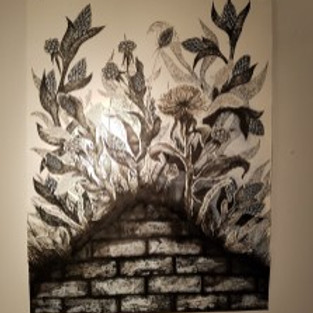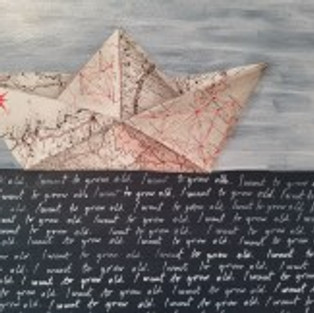Prayer for Travelers: Diary of an Immigrant
- artandcakela
- Nov 18, 2018
- 4 min read
Updated: Jan 28

Vojislav Radovanovic. PRAYER FOR TRAVELERS: Diary of an Immigrant. MuzeuMM. Photo Credit Kristine Schomaker
Prayer for Travelers: Diary of an Immigrant – Vojislav Radovanovic
MuzeuMM, Los Angeles
On view through November 24th
By Genie Davis
Vojislav Radovanovic has created an exhibition so sweet and beautiful it is heartbreaking. With Prayer for Travelers: Diary of an Immigrant, at MuzeuMM through the 24th of November, Radovanovic uses his own experiences in arriving first in France and then in the U.S., and riffs from there on themes of love, acceptance, and the universal immigrant experience, including displacement, cultural heritage, and the power of memory. It is the perfect antidote to the country’s current cultural shame: the present administration’s handling of immigrants.
The Serbian-born artist is exhibiting two distinct but related bodies of work at the gallery: an art-installation featuring hand-painted flags and more traditional drawings on the gallery walls with images of stars and weeds. Weeds are often seen as unwelcome, Radovanovic asserts, but their varied beauty can contain beneficial traits, medicinal properties, nutritious value, and the strength to survive harsh conditions and adapt to new surroundings. For him, the weeds become poetic representations of marginalized people and immigrants.
“We are all immigrants,” the artist relates. “I’ve been depicting weeds in my art for years as a representation of minorities and immigrants; we see weeds as bad plants, and yet weeds have the power to survive and are natural.” He notes that contemporary agriculture, with its focus on weeding-out “is all about the many poisons on the earth that you can now buy in Home Depot.” In short, in his analogy, wiping out weeds may just wipe out the very essence of agricultural life; and in the same way, driving out immigrants may indeed eliminate the healthy diversity, growth, and natural migration of the world’s population.

Vojislav Radovanovic. PRAYER FOR TRAVELERS: Diary of an Immigrant. MuzeuMM. Photo Credit Kristine Schomaker
The exhibition features “Waiting for the Wind” an installation contained within a chain link fence. Behind the fence are arrowheads representing Native Americans – the only non-immigrants in the U.S.; dirt, representing the land itself; and a large flag adorned with beautifully rendered weeds. Flags, like seeds from the weeds, wave in the wind, spreading their message, claiming a land. “The materials I used to make the flag came from the second-hand store. They have the energy of the people who used them, they are mainly sheets, and from them, we have the energy of a cozy home,” he says. In material, design, and intent, Radovanovic is creating a homeland.
Another flag, spread over a large portion of wall space, “ORANS/Kristina Wong as America” features acrylic on used textiles. On it, a woman with her arms elongated and open wide against a starry background, appears to be welcoming everyone to her home, America. Wong makes a perfect welcoming stand-in for the Statue of Liberty.
Radovanovic’s “Unidentified immigrant in Paris 2016” is an acrylic and graphite drawing of a sleeping man, ringed by lines of poetry, created on cardboard. “It is a self-portrait in part but dedicated to a person I met living in Paris,” he says. “In Europe, I confronted a big problem people had with immigrants there, they don’t need passports, they just come.” He says it is hard for them to find a home. “The poem I made up about him is a story about him living in a cardboard box. It reminded me, just the scent of a box, of playing in a box as a child. It is like an imaginary house.”
Here too, the artist is representing the creation of a home, or a place to call home.
Most of the gallery’s wall space is taken up with a series of beautiful, evocative paintings featuring weeds and stars, and mysterious, lyrical landscapes. They are unique and beautiful, many featuring collaged reassembling of past works combined with new drawings and paintings, travel maps, and pages torn from the Bible.
“Wanderers” gives viewers birds and flowering stars against a lush blue background; “Finding a home” reveals stars and poetic words trailing them like comets above a striated landscape. In “Stray Dog,” a canine rests before a bone among weeds, stars bursting with light above him on a dark blue sky. “I want to grow old” makes use of old maps as a kind of wall, above which a bright star peeks into a pale blue sky streaked with the white of clouds. In “Verses Headed for the Weeds,” paper airplanes spin and dive above wavering weeds that seem to be open-mouthed, like baby birds, hungry for knowledge. There is a comet, a “Folding House” sailing through a night sky, a road through uncharted territory illuminated by three bright stars, and “Home,” a nine-piece polyptych made with old maps and silver leaf, the small paper works hung together in quilt-like pattern of dwellings and stars.
Radovanovic’s “Weeds above the Ruins of the Temple” is especially evocative: here, lush weeds, many flowering, are growing in good health from soil accumulated on the half-buried ruins of a temple. Here, the artist seems to be saying, is the future, growing on the past which serves as its base rather than an overpowering force against what is to come.
“Someday, Somewhere, I will finally be at home…” paints an exceptionally bright star on a dark sky above a monochromatic landscape. There is much hope and pathos and longing in the piece. And there is the passionate desire for understanding, love, a safe place for even a “weed” to thrive and grow. Radovanovic has found his own home here in the Los Angeles art scene, which can use and welcome his optimistic, sympathetic, and profoundly lovely view of the world. Welcome to Radovanovic’s America.
#losangeles #california #losangelesartist #art #painting #geniedavis #losangelesart #contemporaryart #immigration #southerncalifornia #abstract #collage #immigrant #artgallery #kristineschomaker #gallery #VojislavRadovanovic #museum #artandcake #artopening #assemblage #artexhibition #installation #ArtandCakeLA #fineart #artists #artist #soloshow #mixedmedia #arts #environment #Prayerfortravelers #artreview #muzeumm #sculpture #artmagazine #ArtandCulture #dtla #drawing































































